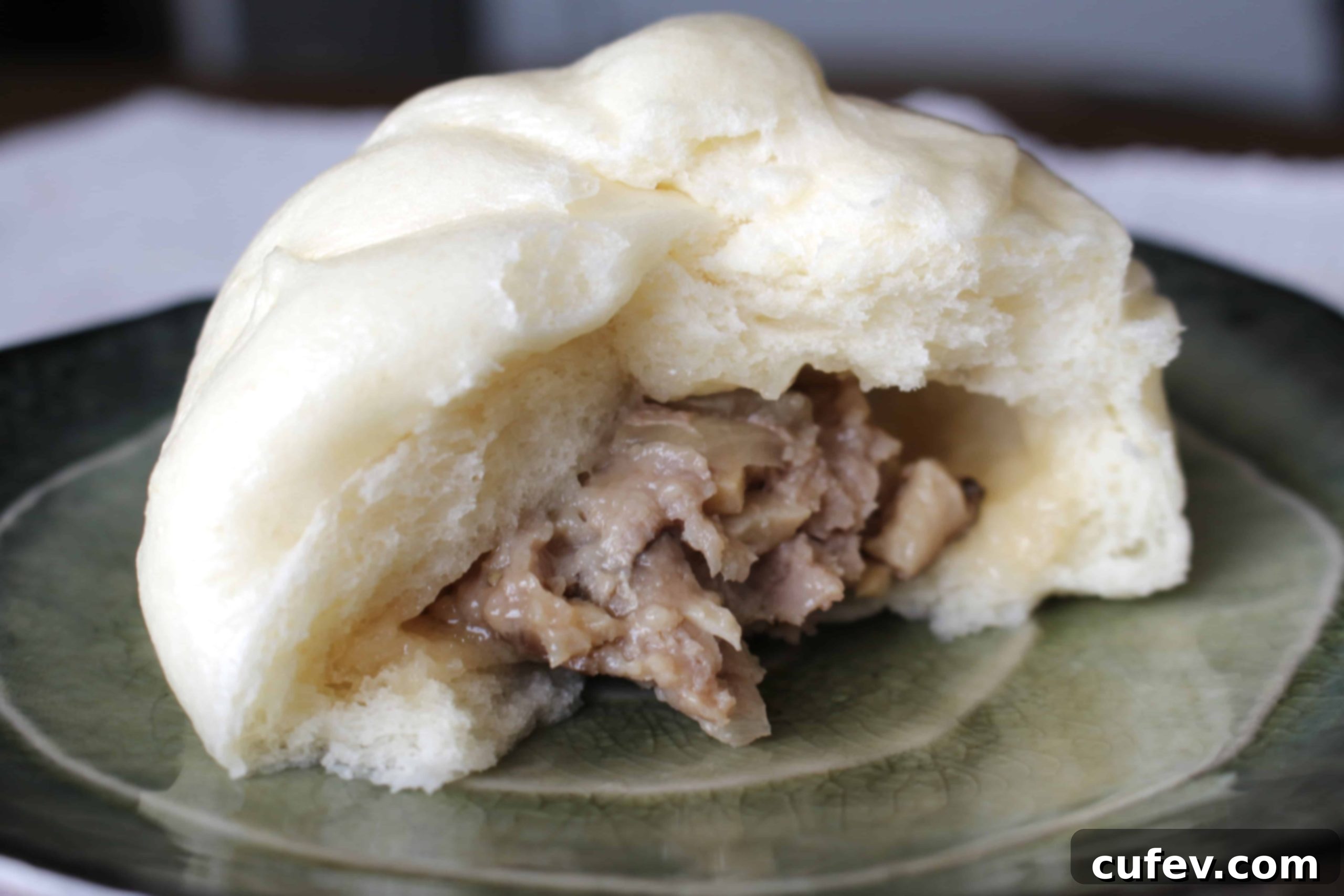Authentic Homemade Steamed Pork Buns (Nikuman/Butaman) Recipe: A Taste of Childhood
Mother’s Day often brings thoughts of sweet treats and decadent desserts. Every year, I typically find myself in the kitchen, baking a special cake or pastry for my mom. However, this year, her request was refreshingly simple: “Please, no sweets. I’m trying to be good.” While I fully support her healthy intentions, it left me pondering what alternative culinary delight could truly convey my love and appreciation.
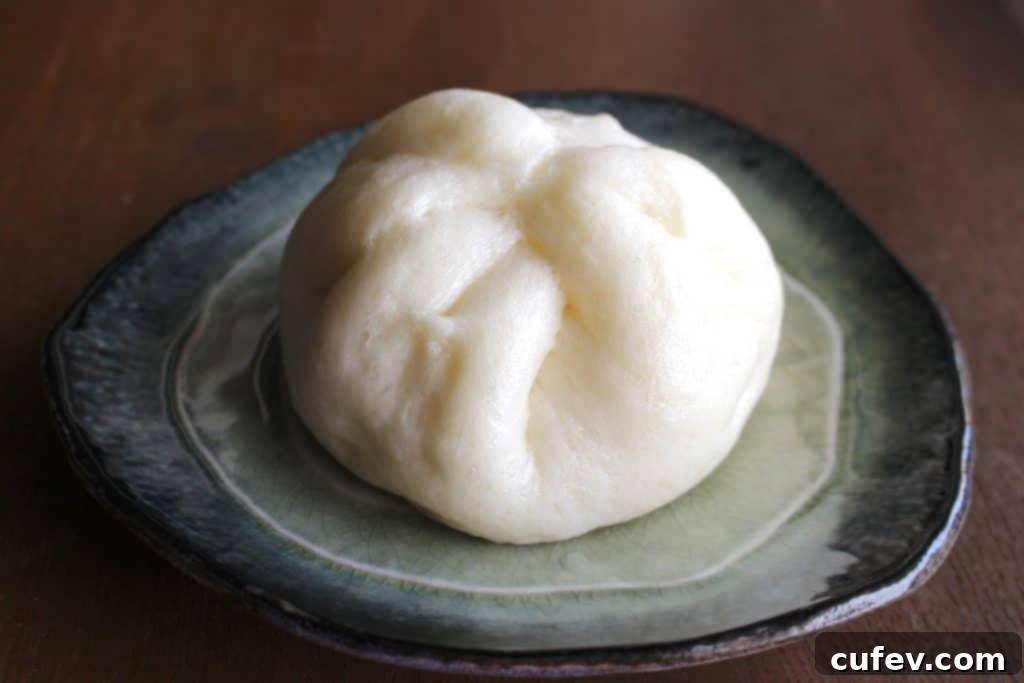
My mind immediately drifted back to a cherished childhood memory: the aroma of freshly steamed pork buns wafting through our apartment building in Japan. Every chilly winter morning, my mom would send me on a special errand – an otsukai – to the tiny bread shop directly across the street. There, I’d purchase warm, fluffy steamed buns, a perfect start to our day. This simple act of buying breakfast wasn’t just about food; it was about the independence and trust my mom instilled in me, even at a young age.
The Charm of Otsukai: A Japanese Tradition
In Japan, it’s a common and heartwarming tradition for children to go on otsukai, which translates to “errand” or “shopping alone.” These small, supervised tasks are designed to teach responsibility and build confidence. My first *otsukai* was to that very bread shop, close enough for my mom to peer out from our balcony, her watchful eyes ensuring my safety as I navigated the familiar path. The shop, run by a kind, elderly woman, always felt like a beacon of warmth and deliciousness on those crisp mornings.
Nikuman vs. Butaman: A Regional Culinary Debate
One particular morning stands out vividly. My mom asked me to buy a couple of nikuman (meat buns) and a couple of butaman (pork buns). Armed with her instructions, I confidently approached the grandma at the shop. When I relayed my order, she simply smiled and informed me that nikuman and butaman were, in fact, the same thing. Being my mother’s daughter, I inherited a certain stubbornness (love you, Mommy!). I earnestly tried to explain that my mother had specifically requested two different kinds. Despite my insistence, I returned home with four identical buns, completely bewildered.
It wasn’t until much later that I understood the regional nuance. In many parts of Japan, particularly in the Kanto region (where Tokyo is located), niku (肉) generally refers to any meat, but when used without a qualifier, it often implies pork in dishes like nikuman. However, in the Kansai region (home to Osaka and Kyoto), niku more commonly refers to beef. To avoid any confusion or disappointment, steamed buns containing pork are explicitly called butaman (豚まん), where buta (豚) means pork, ensuring no one expects a beef filling. This little linguistic and culinary detail adds a fascinating layer to Japan’s rich food culture.
Regardless of their regional appellation, these savory steamed pork buns are undeniably delicious. For me, they represent more than just a meal; they are a nostalgic embrace, a comforting link to my childhood days and the beautiful bond I share with my mom. This Mother’s Day, instead of a sweet treat, I decided to recreate these beloved buns, a savory tribute to a lifetime of cherished memories.
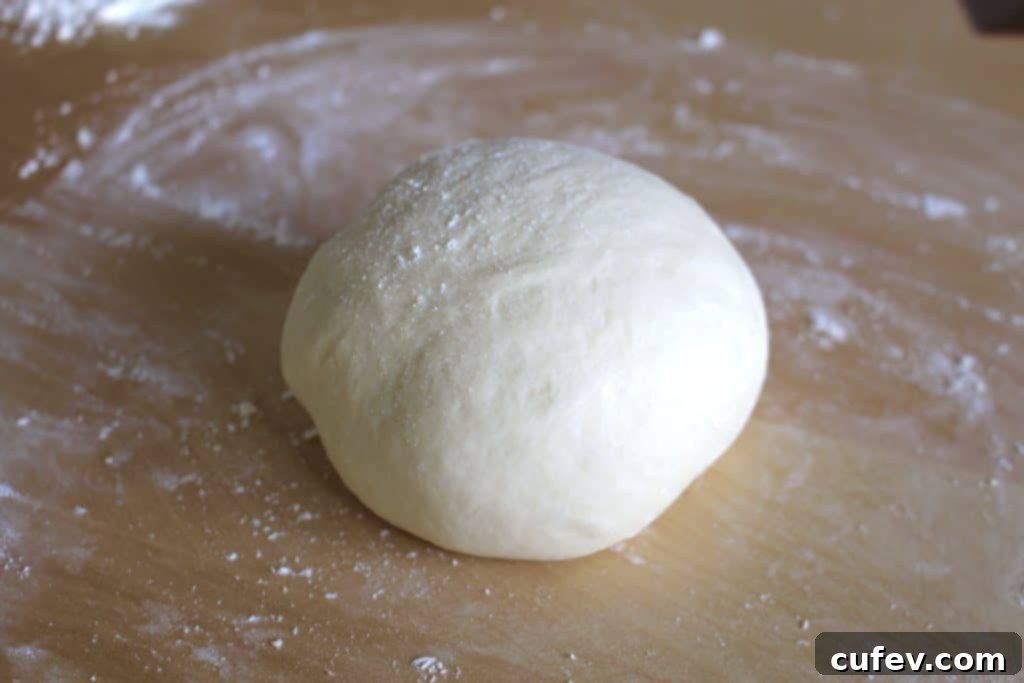
Crafting the Perfect Steamed Pork Buns: A Detailed Guide
Making steamed pork buns from scratch might seem daunting, but it’s a rewarding process that yields incredibly soft, fluffy dough and a rich, flavorful filling. This recipe is designed to be accessible, whether you’re a seasoned baker or a curious beginner. I’ll share how to achieve restaurant-quality results in your own kitchen.
The Dough: The Heart of Your Buns
The secret to wonderfully soft and airy steamed buns lies in the dough. This recipe combines both cake flour and bread flour for a unique texture: the cake flour contributes to the softness, while the bread flour provides structure and chewiness. Granulated sugar not only adds a hint of sweetness but also feeds the yeast, promoting a good rise. A touch of fine sea salt balances the flavors, and skim milk powder helps create a tender crumb and a beautiful white color. Baking powder is an extra leavening agent often used in steamed buns to ensure they stay fluffy even after cooling. Finally, oil adds moisture and elasticity, making the dough easier to work with.
For convenience, I highly recommend using a bread machine for the dough. Simply add all the dough ingredients into the bread machine pan according to your machine’s instructions (usually liquids first, then dry ingredients, with yeast added last to a small well in the flour). Select the “dough” setting, and let it do all the hard work of mixing and kneading until a smooth, elastic dough forms. The bread machine will also handle the first proofing cycle, ensuring your dough doubles in size in an ideal environment.
If you prefer the traditional method or don’t have a bread machine, making the dough by hand is entirely possible and quite therapeutic, though it requires a bit more time and effort. In a large mixing bowl, combine all the dough ingredients. Mix them until a shaggy dough forms, then turn it out onto a lightly floured surface. Knead the dough vigorously for about 10-15 minutes, or until it becomes smooth, elastic, and no longer sticky. You should be able to stretch a small piece of dough thin enough to see light through it without tearing (the “windowpane test”). Once kneaded, place the dough back into a clean, lightly oiled bowl, cover it tightly with plastic wrap, and let it proof in a warm place until it has doubled in size. This can take anywhere from 1 to 2 hours, depending on the ambient temperature and humidity.
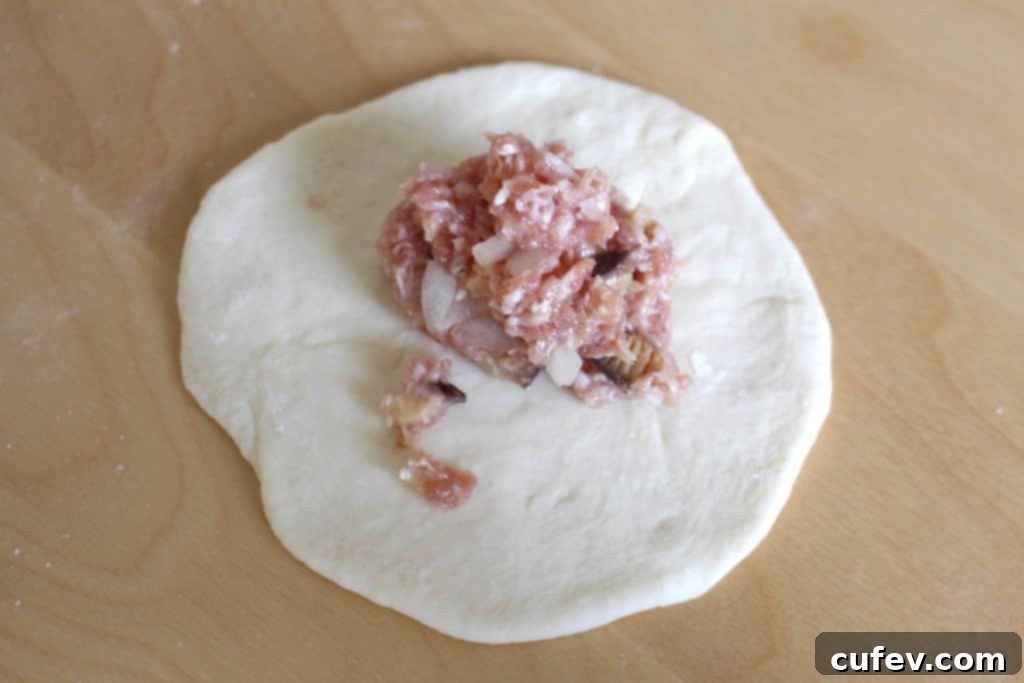
The Flavorful Filling: A Savory Delight
While your dough is busy proofing, it’s the perfect time to prepare the delectable filling. This savory mixture is packed with umami and a wonderful medley of textures. Ground pork forms the base, complemented by the earthy notes of rehydrated shiitake mushrooms, which add a delightful chewiness. Finely chopped onion brings a gentle sweetness and aromatic depth, while boiled bamboo shoots provide a pleasant crunch. Grated ginger is crucial for freshness and a subtle spicy kick that cuts through the richness of the pork. Arrowroot powder acts as a binder, helping the filling stay juicy and cohesive within the bun.
To assemble the filling, simply add the ground pork, finely chopped rehydrated shiitake mushrooms, finely chopped medium onion, finely chopped boiled bamboo shoots, grated ginger, arrowroot powder, soy sauce, oyster sauce, sake, and sesame oil into a large bowl. Using your hands, mix all the ingredients thoroughly until they are well combined and slightly sticky. This ensures that every bite of your steamed bun is bursting with flavor. Once mixed, divide the filling into 8 equal portions. I learned this the hard way: it’s crucial to portion it out properly to avoid ending up with some buns that are disappointingly scant on filling, as I once did!
Shaping Your Steamed Buns: Simplicity for Perfection
Once your dough has completed its first rise and has beautifully doubled in size, it’s time for the fun part: shaping the buns! Gently turn the dough out onto a lightly floured surface. Avoid overworking it at this stage. Divide the dough evenly into 8 equal pieces. For best results and consistent bun size, you can weigh each piece. Roll each piece into a smooth ball and set them aside, covering them with plastic wrap to prevent them from drying out.
Take one dough ball and, using a rolling pin, roll it out into a circular shape, approximately 6 inches (15cm) in diameter. The key here is to make the edges slightly thinner than the center. This thinner edge will make it easier to gather and seal the bun, while the thicker center will hold the filling without tearing. Place one portion of the prepared filling in the center of the rolled-out dough.

Now for the shaping technique. While many traditional methods involve intricate pleating, I’ve found a simpler, equally effective way that’s perfect for home cooks. Bring two opposite corners of the dough to the center and firmly pinch them together. You’ll then have four more corners or edges remaining. Bring these new “corners” towards the center and pinch them together securely, forming a neat parcel. Continue pinching all the seams together at the top to seal the bun completely. This method creates a lovely, rustic-looking bun that’s secure and holds its filling beautifully.
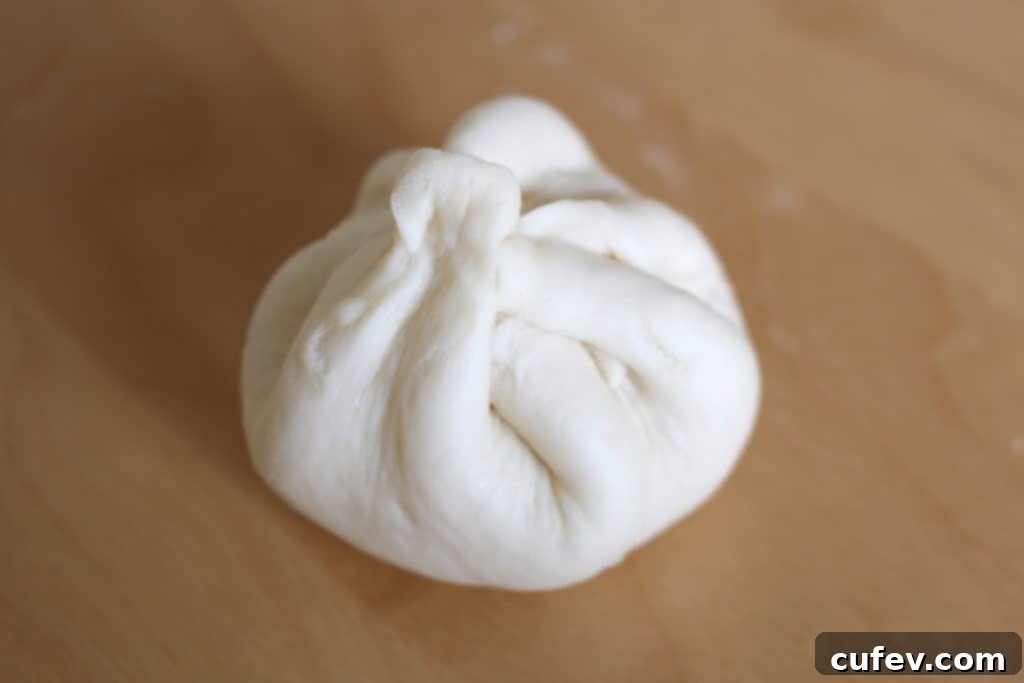
Voila! You now have a perfectly sealed, homemade steamed pork bun. While mastering the art of traditional pleats can be impressive, this simplified pinching method saves time and effort without compromising on taste or texture. It ensures your buns are neatly closed and ready for steaming.
Steaming to Perfection and Serving
Once all your buns are shaped, place each one on an individual piece of parchment paper. This prevents them from sticking to the steamer basket. Arrange them in your steamer basket, ensuring there’s enough space between each bun for expansion. Cover the steamer basket with plastic wrap or a damp cloth and let the buns rise for another 15 minutes. This final proofing, often called the second rise, is crucial for achieving that characteristic light and fluffy texture.
When the buns are puffy and ready, place the steamer basket over a pot of rapidly boiling water. Make sure the water level is not so high that it touches the bottom of the steamer. Steam the buns on high heat for 15 minutes. High heat ensures a quick, powerful steam that cooks the buns evenly and prevents them from becoming tough or chewy. After 15 minutes, turn off the heat but leave the lid on for an additional 2-3 minutes. This allows the buns to settle and prevents them from deflating due to a sudden change in temperature.
Carefully remove the steamed buns from the steamer and transfer them to a wire rack to cool for a couple of minutes before serving. This brief cooling period helps them firm up slightly and makes them easier to handle. Serve them warm as a delightful breakfast, a satisfying snack, or a unique appetizer.
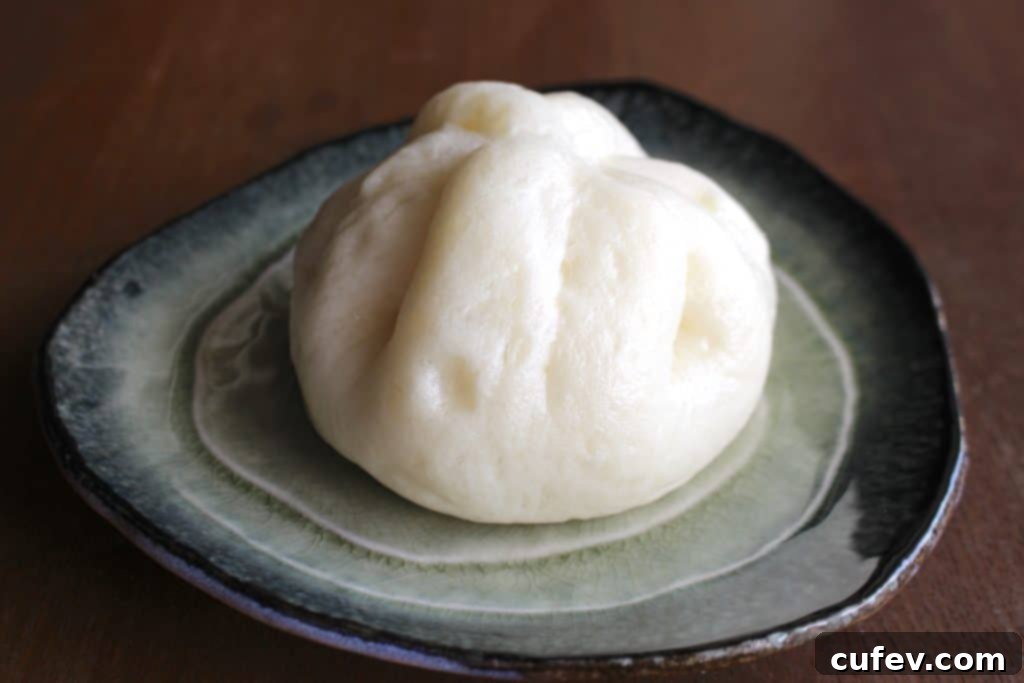
While your homemade steamed pork buns might not have the perfectly uniform, pleated appearance of those found in a dim sum restaurant, don’t let that deter you. The moment you take that first bite, you’ll forget all about their looks. The tender, slightly sweet dough combined with the savory, aromatic pork filling is simply irresistible. This recipe offers a taste of authentic flavor and a hearty, comforting meal.
Storage and Reheating Tips
One of the best things about these homemade steamed pork buns is that they freeze beautifully. If you have leftovers or want to prepare a batch in advance, simply allow the freshly steamed buns to cool completely on a wire rack. Once cooled, place them in an airtight freezer-safe bag or container. They can be stored in the freezer for up to 2-3 months. For busy mornings or a quick snack, you can easily reheat them in the microwave for 1-2 minutes until warmed through, or for an even better texture, re-steam them for 5-7 minutes. They’ll taste almost as fresh as when they were first made.
This Mother’s Day, I am filled with immense gratitude. To my dearest mother, thank you for every single thing you have done for me, from teaching me independence with those early morning otsukai to instilling in me a love for wholesome, comforting food. These steamed pork buns are more than just a recipe; they are a tangible piece of our shared history, a delicious reminder of your love, guidance, and the warmth of home. Love you!
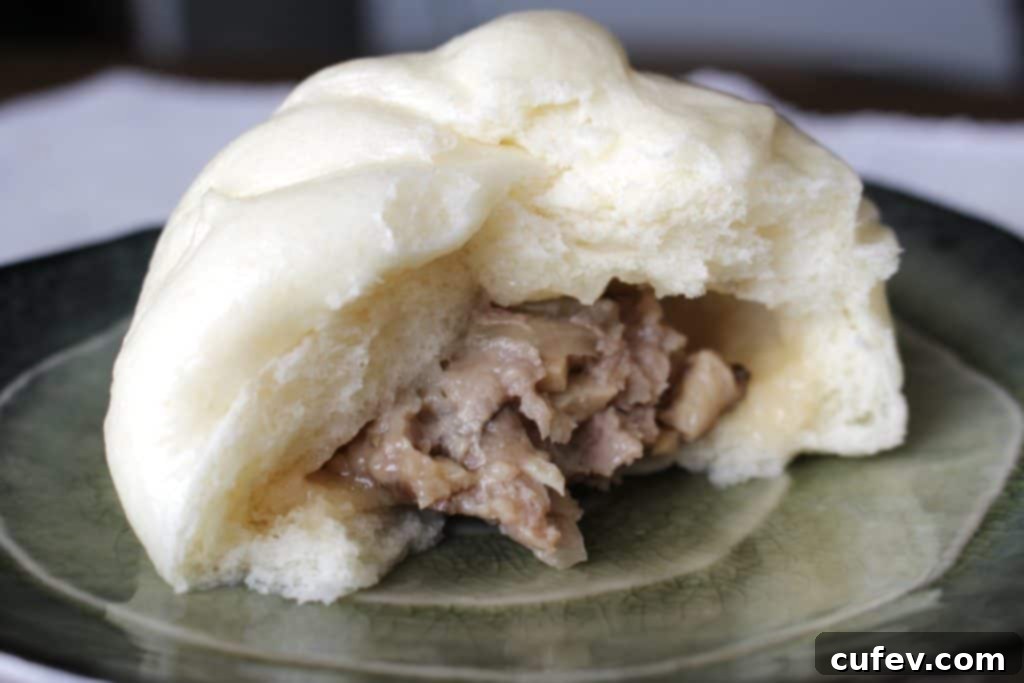
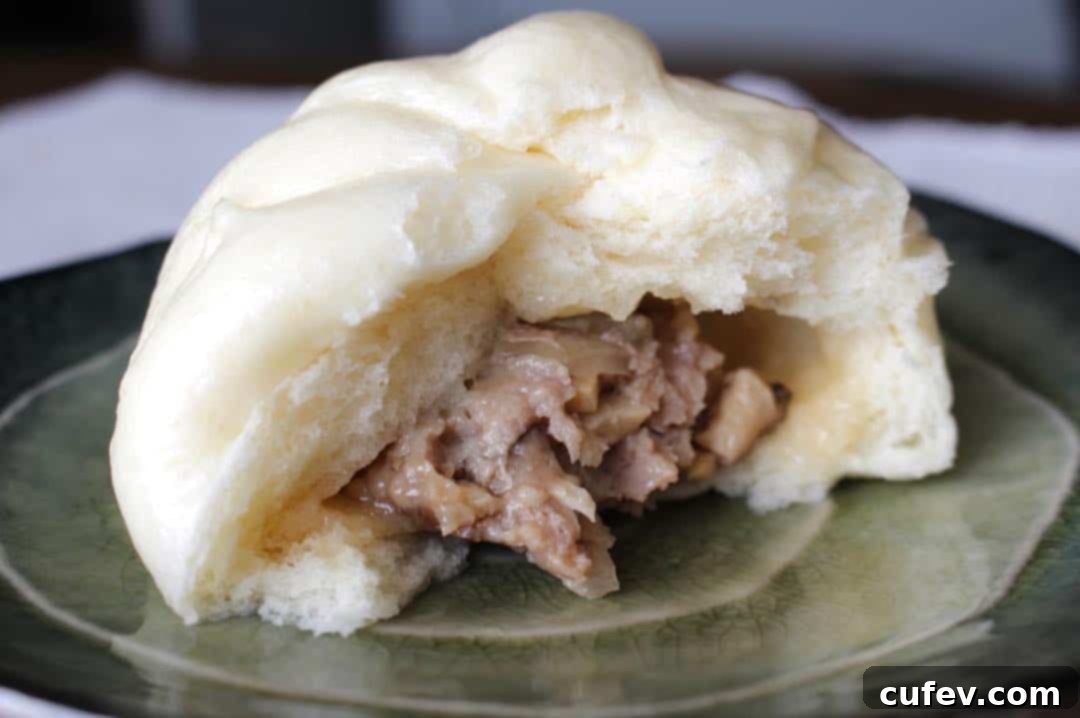
Steamed Pork Buns (Nikuman/Butaman)
Print
Pin
Rate
Ingredients
Dough
- 1¾ cup + 1 teaspoon (200g) cake flour
- ¾ cup + 4 teaspoons (100g) bread flour
- 3 tablespoons (37.5g) granulated sugar
- ⅛ teaspoon fine sea salt
- 1 tablespoon skim milk powder
- 2 teaspoons baking powder
- 1 tablespoon oil
- ½ cup + 2 tablespoons (150ml) water
- 1¾ teaspoons active dry yeast
Filling
- ⅔ lbs (250g) ground pork
- 3 dried shiitake mushrooms, rehydrated in water and chopped finely
- ¼ medium onion, chopped finely
- 1.8 oz (50g) boiled bamboo shoots, chopped finely
- 1 teaspoon grated ginger
- 1 tablespoon arrowroot powder
- 1 tablespoon soy sauce
- ½ tablespoon oyster sauce
- 1 tablespoon sake
- 1 tablespoon sesame oil
Instructions
-
Prepare the Dough: If using a bread machine, simply add all dough ingredients into the pan and set it on the “dough” cycle. If making by hand, combine all dough ingredients in a large bowl, mix until a shaggy dough forms, then knead on a lightly floured surface for 10-15 minutes until smooth and elastic. Place the dough back in an oiled bowl, cover with plastic wrap, and let it proof in a warm place until doubled in size (1-2 hours).
-
Prepare the Filling: While the dough is proofing, prepare the filling. In a separate bowl, add all the filling ingredients (ground pork, rehydrated shiitake mushrooms, chopped onion, bamboo shoots, grated ginger, arrowroot powder, soy sauce, oyster sauce, sake, sesame oil). Mix thoroughly until well combined. Divide the filling mixture into 8 equal portions.
-
Shape the Buns: Once the dough is ready, turn it out onto a lightly floured surface. Divide the dough evenly into 8 pieces. Roll each piece into a smooth ball and cover them with plastic wrap to prevent drying. Take one dough ball, and using a rolling pin, roll it out into a 6-inch (15cm) circle, making the edges thinner than the center.
-
Place one portion of the filling in the center of the rolled-out dough. Bring two opposite corners of the dough to the center and pinch them together. Then, gather the remaining four edges towards the center and firmly pinch them all together to seal the bun completely. Repeat for all 8 buns.
-
Steam the Buns: Place each shaped bun on an individual piece of parchment paper. Arrange them in a steamer basket, cover with plastic wrap or a damp cloth, and let them rise for another 15 minutes. Once ready, place the steamer over rapidly boiling water and steam on high heat for 15 minutes. Turn off the heat and leave the lid on for 2-3 additional minutes. Carefully remove the buns and let them cool on a wire rack for a couple of minutes before serving. Enjoy your delicious homemade steamed pork buns!
